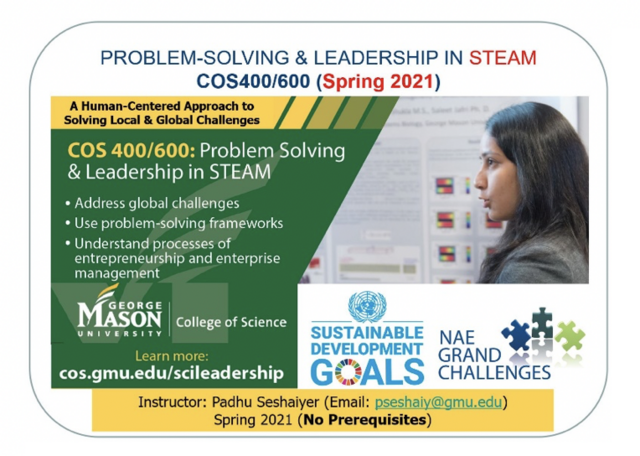Admission CTAs
From real-world context to building STEM competencies
Imagine if we as science/technology/engineering/math (STEM) educators can enhance our educational philosophy from “here is the STEM, go solve the real-world problem” to “here is the real-world problem, let us find the STEM to do it.” While the educational philosophy all across the globe is geared towards the former approach as most educators are trained that way, there has been a big paradigm shift in education in the last few years to move towards the latter. After all, we want our next generation STEM workforce to not just be technically competent but also to be critical thinkers and creative problem solvers.
This philosophy aligns with Mason’s College of Science focus on going beyond a content-focused approach in training students to a competency-focused approach. This means providing opportunities to students to a variety of frameworks including learning by doing, inquiry-based learning, active learning, experiential learning, project-based learning and challenge-based learning.
Our college has championed delivering such frameworks through both curricular innovations and community engagement programs.
Over the years, several faculty have successfully transformed their science- and mathematics-focused classes to engage students in the curriculum, helping them use what they learned to solve real-world challenges. One example of such a class is COS400: Multidisciplinary Problem Solving and Leadership in STEAM that will employ a human-centered approach to solving real-world challenges posed by the UN Sustainable Development Goals as well as the National Academy of Engineering Grand Challenges. This class challenges the students to employ a human-centered design and systems thinking approach to solving real-world problems using STEAM (Science, Technology, Engineering, Arts and Mathematics) tools. This class along with COS300: Professional Preparation for STEM Disciplines provides the opportunity for students in any major the option to earn a minor in the college on Scientific Leadership and Practice, something that will differentiate Mason students as they enter the STEM workforce.
Along with such curricular innovations, the College of Science also has been a big proponent of community engagement programs that “engages early and engages ALL”. Some of these successful programs include FOCUS: Females of Color Underrepresented in STEM, summer middle school camps and high school academy, STEM bridge camps for incoming freshmen looking to major in STEM disciplines at Mason, and our Learning Assistants Program to support the faculty offered through the STEM Accelerator Program.
Other popular programs include ASSIP (Aspiring Summer Scientist Internship Program), AACTR (Academic Affairs Community of Transfer Researchers) and the RADSS Program (Rural and Diverse Student Scholars) that inspire diverse students at various levels to pursue research.
This fall, we recently established the College of Science VLC (Virtual Learning Community) to enhance students experience in the college through additional engagement both inside and outside the classroom.
Let us know what you’re doing to encourage science exploration in your communities. For example, for years, the college and I have been active participants in the USA Science and Engineering Festival, the biggest STEM festival in the world. Despite not connecting face to face, my presentation in this free, virtual SciFest event happening this week is a great opportunity to share the power of mathematical science with more people. The virtual environment presents new opportunities.
If you’d like to share ideas or learn how to participate in the college’s community engagement and outreach programs, please contact me at pseshaiy@gmu.edu.

